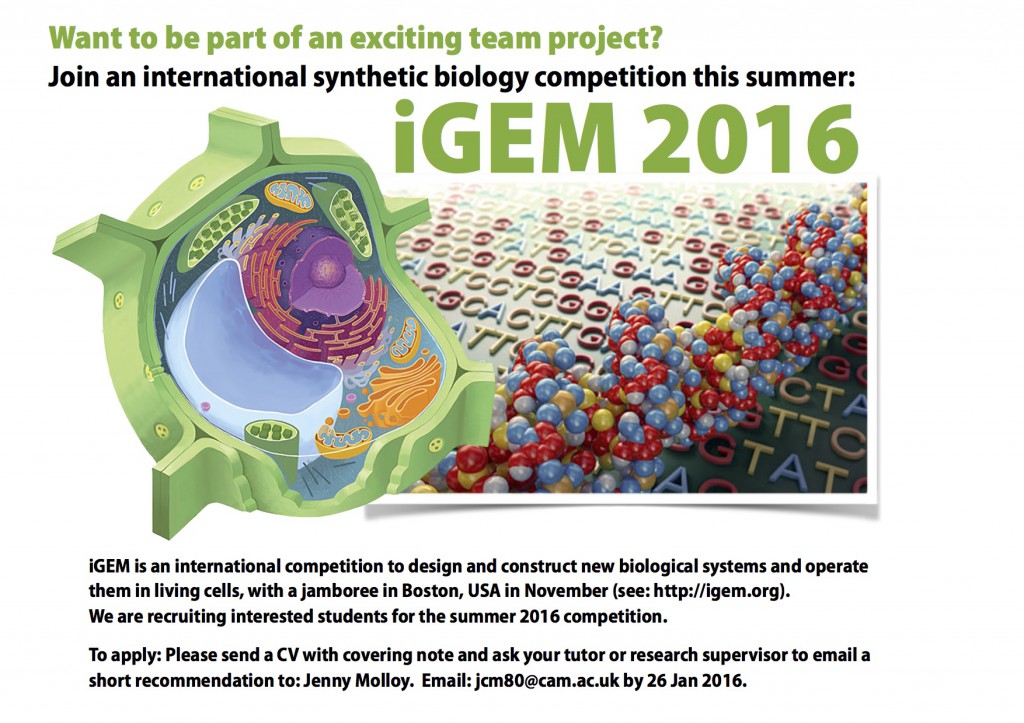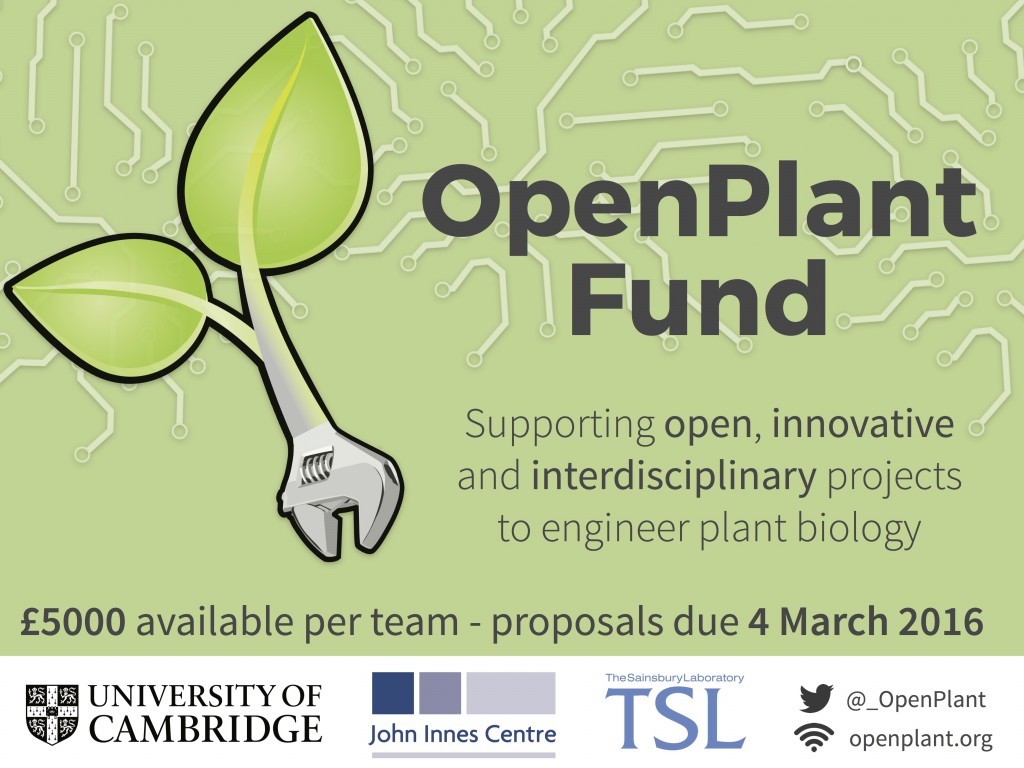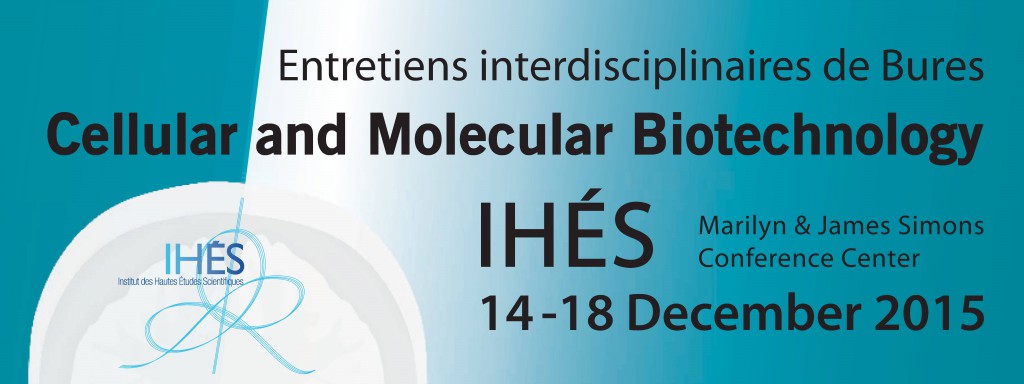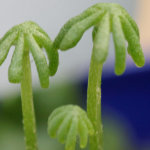 To apply: Please send a CV with covering note and ask your tutor or research supervisor to email a short recommendation to: Jenny Molloy Email: jcm80@cam.ac.uk
To apply: Please send a CV with covering note and ask your tutor or research supervisor to email a short recommendation to: Jenny Molloy Email: jcm80@cam.ac.uk
The new field of Synthetic Biology is based upon the adoption of (i) engineering principles of abstraction and modularity, (ii) computational tools from Systems Biology and (iii) new genetic engineering techniques and components - for the rational design and assembly of new biological systems. It is a practical subject, concerned with the construction of new living artifacts. The new interdisciplinary field is being propelled by the need for improved plant and microbial feedstocks, bioenergy sources, and new catalysts for bioprocessing. Synthetic Biology is seeing a rising tide of new scientific activities, research funding and commercial investment.
iGEM is an international undergraduate synthetic biology competition where student teams are given access to DNA parts from the Registry of Standard Biological Parts at the Massachusetts Institute of Technology (MIT). The aim is to use these and other new parts to design and construct new biological systems and operate them in living cells. (see: http://igem.org). Cambridge provided the first team from the UK (see: http://www.synbio.cam.ac.uk). Since 2005, there has been wide interdisciplinary support for a University of Cambridge team in the iGEM competition. The competition provides a practical, laboratory based experience, with a focus on bottom-up design and assembly techniques, standardised biological components and cellular devices. This year sees the introduction of a new track for the engineering of plants in the competition. We are drawing together a team who can contribute in an interdisciplinary way to development of new DNA parts, quantitative methods and instrumentation for engineering of plant systems.
The team will be run jointly with the John Innes Centre, an independent, international centre of excellence in plant science and microbiology based in Norwich, with a mission to improve agriculture, the environment, human health and well-being, and engage with policy makers.
Participation in the iGEM competition offers:
- Interdisciplinarity and teamwork. Students from Biology, Engineering, Computing and the Physical Sciences participate in the iGEM team.
- Hands-on practical experience. The iGEM competition provides laboratory experience with the handling of synthetic biological systems to provide better grounding in practical skills for future project work.
- Project and group based learning. Students share team work in laboratory work, biological design, project management and presentation.
- Student exchange. In addition to promoting improved collaboration across Cambridge, participation provides opportunities for links with scientists at the John Innes Centre, collaboration and international exchange.
- Lab resources. The iGEM team will have access to labs equipped for handling biological systems and construction of hardware, including 3D printing.
- Open Instrumentation. Students will be able to work with Arduino and Raspberry Pi-based microcontrollers and interface these with optics, microelectronics and motors for DIY instrumentation.
Application details:
iGEM studentship funding will be available for up to 10 first and second year Cambridge undergraduates to allow participation in the competition. The competition will start on Monday, 27th June 2016, and will be based in the Department of Plant Sciences, University of Cambridge. The first two weeks of the competition will include a crashcourse in Plant Synthetic Biology, with brainstorming and practical exercises. The studentships will include a stipend of £180 per week for ten weeks, registration fees for the competition, exchange visits with the John Innes Centre, access to state-of-the-art laboratory facilities and workshops and attendance at the global iGEM Jamboree at Boston, USA in November 2016.
Faculty advisors are:
Jim Ajioka (Pathology), Alexandre Kabla (Engineering), Jim Haseloff (Plant Sciences) and George Lomonossoff (John Innes Centre).
For further information on the competition see http://www.igem.org.

![[Closes 24 Nov 2107] Apply now to the OpenPlant Fund!](https://images.squarespace-cdn.com/content/v1/54a6bdb7e4b08424e69c93a1/1509564315902-TUO4I6QRWI9TT8UGSIAJ/OpenPlantTwitter_400x400+%281%29.jpg)

![[Closes 7 Mar 2017] OpenPlant Research Associate (Haseloff Lab)](https://images.squarespace-cdn.com/content/v1/54a6bdb7e4b08424e69c93a1/1486552818859-FH76MCA8SMFU93WB85RX/OpenPlantTwitter_400x400.jpg)






 The Madagascar Periwinkle (Catharanthus Roseus) - The plant that makes vincristine
The Madagascar Periwinkle (Catharanthus Roseus) - The plant that makes vincristine